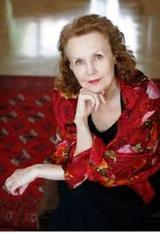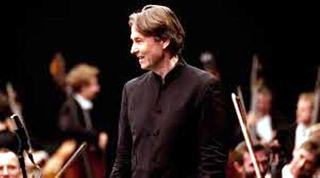|
Back
A Special Composer, A Spatial Evening New York
Park Avenue Armory
10/11/2016 - & October 13*, 2016
Kaija Saariaho: Lonh for soprano and electronics – D’OM LE VRAI SENS for Clarinet and Orchestra (New York Premiere) – Lumière et Pesanteur (U.S. Premiere) – Circle Map (New York Premiere)
Jennifer Zetlan (Soprano), Kari Kriikku (Clarinet)
New York Philharmonic Orchestra, Esa-Pekka Salonen (Conductor)
Pierre Audi (Mise en espace), Jean-Baptiste Barrière (Video and Projection Designer), Jennifer Tipton (Lighting Designer)

K. Saariaho (© Courtesy of the Artist)
Ninety straight minutes from the pen of the wondrous Finnish composer Kaija Saariaho might have a tendency to drift away from the mind. She does not write Impressionist wisps ever. But her blocks of sound, her huge orchestral forces can drift off course as much as they drift to the listener. Her colors are fierce enough, but they sometimes seem unanchored: not sporadic (for she is too careful for that), but roaming in a dozen directions at once. And her inspirations are so incredibly eclectic–ranging from Medieval paintings to mythological animals to Persian poetry to modern philosophical meditations–that the layers of meaning pile up on one another. Massive thoughts, massive sounds, the works of a mighty mind.
What is always present in Ms. Saariaho’s work is the representation of the visual: not the imitation of the visual (à la Strauss), but a musical visualization. Thus, last night’s 90-minute epic presentation on the 55,000 square-foot arena-style stage of New York Armory’ Drill Hall was actually a dual presentation. Four major works by Kaija Saariaho, and the visual projections of the multi-faced composer artist
Jean-Baptiste Barrière.
There is no way to show them here. These pictures move with the same ineffable certainty as Ms. Saariaho’s music. But they are even more magical. Yes, we have the clouds, the wispy gauzy atmosphere as a beginning. Yet Mr Barrière goes far far more in his discoveries.
In a song cycle by the consummate soprano Jennifer Zetlan, as she wandered around the arena. Mr. Barrière gave us flowers and flames and sunsets–and the live projection of Ms. Zetlan’s face actually transformed into these natural images, coming in and out of the pictures like she was a force of nature herself. (Which she definitely is.)

K. Kriikku at NY Armory (© New York Armory)
In the clarinet concerto written for Kari Kriikku, D’OM LE VRAI SENS, the movements are based on a) the great tapestry in Paris’s Medieval Museum, The Lady And The Unicorn and b) the six senses. What did Mr. Barrière do? Yes, we had reproductions of the original tapestries, but they became deconstructed. The images of woman and unicorn disappeared, returned, became intertwined, until we seemed to imagine these images in our own mind.
(And all this while clarinetist Kriikku danced around the arena, a Pied Piper summoning members of the Philharmonic, gyrating, playing quarter-tone music with an impossible ease.)
Finally, Mr. Barrière became the calligrapher. In six poems by the Persian poet Rumi, the images were of a hand slowly, painstakingly writing the Arabic letters to the Persian sounds. Yet here, even the letters disappeared, became transformed, metamorphed into birds or air or...or Arab calligraphy which resembled no letters known to man.
If Ms. Saariaho’s music or her fastidious program notes sometimes roamed into an Elysium of its own, Mr. Barrière’s projections colored and painted the notes. Not literally, of course, but as a collaborative adjunct which was frankly more dazzling than the music.
This is never to denigrate the music itself. No matter what the intricacy of the lines, Ms. Saariaho has the clarity a Debussy, the vision of a Boulez. The first work here, a setting from part of her Le Passion de Simone, seemed to drift onwards, yet had outbursts which seemed (rare for the composer) almost angry. “Simone” was Simone Weil, the great Jewish philosopher, and one felt the composer was giving an intensity to a person, rather than an idea.
Her clarinet “concerto” was anything but a concerto. The great Kari Kriikku has worked with Ms. Saariaho many times, but this was the first complete work. Yet we had no “Allegro” ”Andante” movements. They were movements of the six senses, and the clarinetist wove his way through the audience, into the orchestra, weaving his instrument, playing with the orchestra, coming out with an almighty high-register shriek, returning, while the players stood for him, creating a partnership, and then walking solemnly out.
This was indeed “spatial” music. Both the Medieval pictures and the clarinet itself were “unicorns”. It was not a great clarinet concerto, any more than Harold In Italy was a great viola concerto. But it was theater, image, music together.
Lonh, meaning “afar” in Provençal, consisted of eight stanzas translated from the same language, and Ms. Zetlan, chanted, sung and seemed to meditate with her usual brilliance. The lighting changed as she walked through the audience, even the sounds became electronically louder or softer.
Yet Ms. Zetlan the soprano was far far outshadowed by Mr. Barrière’s inspiration to transport the singer to the large screen, her face admist flowers and suns.
It was a philosophical image, a kind of musical/artistic pantheism, which I will remember long after the music.

E.-P. Salonen (©NY.carpediem.com)
Ms. Saariaho’s compatriot and champion, Esa-Pekka Salonen, was at the helm for the final work, based on six stunning poems by Rumi, with those aforesaid pictures of the pen and the Arabic calligraphy. More than orchestral coloring, though, Ms. Saariaho could not avoid the lush Persian words, which were momentarily spoken during the piece.
Like the rest of the program, one could think of Ms. Saariaho and Mr. Barrière as shamans, ushering in their own muse/magicians for us congregants.
I saw it more as Greek theater. Not the theater of Aristophanes or even the emotions of Euripides. Rather the theater of Aeschylus in the later Oedipus dramas. Sounds which were never quite comprehended yet never alien. Sacraments floating to the furthest reaches of the Armory. Musical/painting prayers never answered but (in the words of John Dowland), “Born and died for our delight.”
Harry Rolnick
|